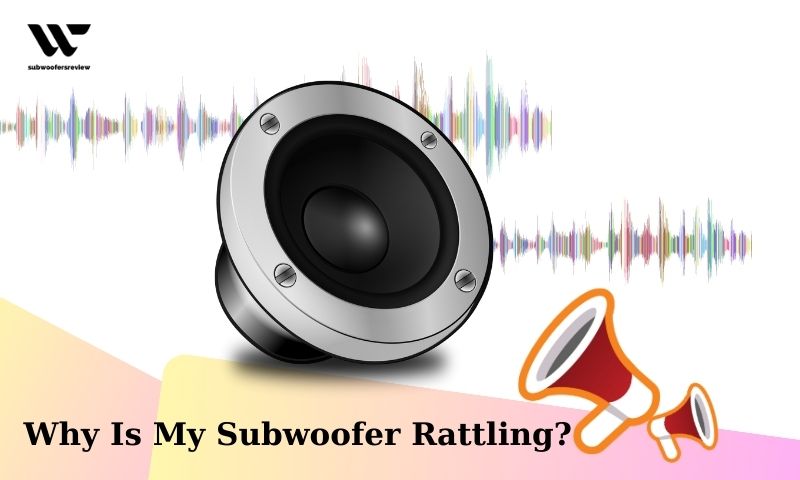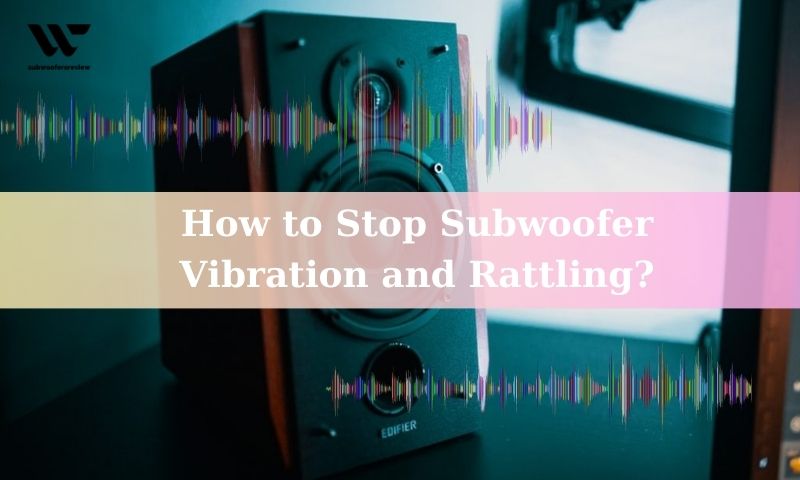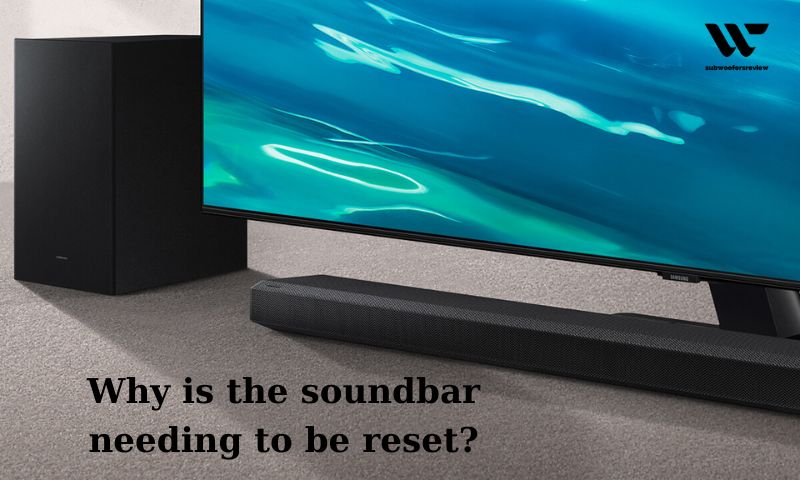Why Is My Subwoofer Rattling? Your subwoofer began to shake and vibrate as soon as you turned on your music system. Nobody, especially music enthusiasts, wants to be in that terrible scenario. There are a number of weird noises that might give you the itch.
You don’t need to worry, though, since subwoofersreview.com will our my extensive expertise of audio to help you address the problem of a rattling subwoofer. If there are any problems with your car’s subwoofer, you can also remedy them.
Without further ado, let’s get started to answer the question “Why Is My Subwoofer Rattling?”!
Why Is My Subwoofer Rattling?

Find the cause of your subwoofer’s vibration should be your top priority. So, Why Is My Subwoofer Rattling? To find and correct the issue right away, examine the following causes:
- Loose Wires: Once wires are not securely fastened, the vibration of the car causes them to move and rub against other objects, making a rattling sound. Furthermore, as wires become loose through wear and tear or incorrect installation, they may come into touch with one another and spark, which may add to the rattling sound.
- Loose Components: If a part (such as a screw, nut, or bolt) is not well fastened, it may vibrate and make noise. You can hear these vibrations if they are loud enough. The subwoofer will vibrate and move back and forth, though, if screws at the edge of its attachment to the box are removed.
- Underpowered Sub: When a subwoofer is connected to a home or automobile music system with insufficient power, the sound waves from the speakers may trigger the subwoofers to shake.
- Damaged Speaker Cone: Once the speaker cone is damaged, the subwoofer may rattle. The broken or torn cone is not structurally solid enough to sustain the sound vibrations brought on by audio impulses.
- Rattling noises are produced as a result of undesired resonance that occurs while a signal travels through a damaged cone.
- Aged Subwoofer: The subwoofer may lose flexibility with time, which could affect performance and increase distortion. When exposed to sound waves, the debris that has accumulated on the cone over time may cause it to vibrate. This shaking is audible through the speaker’s housing.
- Bad bass frequency: Excessive vibrations from an excessive low-pitched frequency are what cause subwoofer rattling. An undesirable sound quality results from the speakers vibrating uncontrollably due to excessive bass that enters the box and strikes the subwoofer.
If any of the aforementioned issues arise in your case, you can rapidly resolve the subwoofer rattling by simply exerting control over it.
If you are struggling with your subwoofer that does not working any more, here is another article for you: Why Is My Subwoofer Not Working? Ways To Fix Correctly!
How to Stop Subwoofer Vibration and Rattling?

Now that we are aware of the causes of subwoofer vibration and rattling, you have the answer fpr the question “Why Is My Subwoofer Rattling?”, let’s move on to the procedures to remedy:
Loose cables
By following these easy methods, you can rapidly fix your shaky cables.
- First, by just listening and touching, find the source of the rattling. Try removing and replacing all of your cables from the subwoofer as well as receiver to see if it solves the problem.
- Fantastic, you have located the vibration’s origin. It’s time to secure the connection at this point. Before you begin, make sure the power sources are completely unplugged to protect the security of both you and your sound system.
- Using a pair of pliers, hold the wires tightly and twist them together. Make sure not to tighten them too much.
- After connecting the wires, gently press and pull them to make sure they stay attached. Repeat the tightening procedure if any loose connections are discovered.
- Finally, reconnect your power sources and test the subwoofer to make sure it is operating properly.
Congratulations! If there is no subwoofer rattle and everything sounds clear, you have solved the problem.
Free-Moving Parts
If loose parts are causing the subwoofer to vibrate, use the procedures below to rapidly resolve the issue:
- Determine which components require tightening first. To complete this work, I typically remove the subwoofer cover (if present) and check each component, including the screws, nuts, and bolts.
- Make sure all the unfastened sbolts, crews, and nuts are secured and, if necessary, tightened. You might need to replace some of the insulation or wiring if it appears worn or frayed.
- Make sure there are no holes in the insulation that would permit unwelcome noise to arise after you have finished your inspection and tightened all of your components. To fill in these spaces, if necessary, apply more foam or rubber gaskets.
- Reattach the subwoofer cover and check the rattle once more. Try shifting the subwoofer to a different spot or position if you still hear rattling.
Underpowered Sub
You’ll have to replace your amplifier, which can give your automobile subwoofer more power, to eliminate the unpleasant noise caused by the underpowered subwoofer. By purchasing the proper-sized amp, the subwoofer can accurately reproduce low frequencies. Choose an amplifier with a larger wattage rating than the RMS value of your subwoofer in order to power your weak subwoofer.
Overpowered Subwoofer
If you think your speaker or sub is getting too much power, you should turn down your amplifier’s signal output. By manually lowering the output level or utilizing a limiter or crossover on your amplifier, you may instantly reduce the signal output.
Damaged Speaker Coil or Cone
If your cone is broken, your subwoofer can rattle. You must determine how much of cone needs to be repaired.
- If the tear is minor, you can rapidly repair the cone by applying rubber cement to the damaged region.
- If there is a significant tear, you will regretfully need to buy a new cone to stop the rattling.
- If everything in the previous section functions properly but is still rattling, you must replace your worn-out subwoofer with a new one.
Fix Poor Bass Frequency
To correct the poor frequency, take the following actions:
- Change the sound system’s audio parameters.
- Make sure you are listening to music with good bass.
- You can modify the subwoofer option’s bass frequency.
Dampen The Sound Waves
Using acoustic foam and sound deadener in your car’s interior or trunk is one of the easiest fixes. Incoming sound waves are absorbed and muffled by these materials, which lessens the amount of vibration that creates the rattling. Make careful to extensively spray the foam over all the walls and surfaces in which the subwoofer is situated, ideally even behind it. Furthermore, placing a layer of carpet or fabric will further reduce vibrations.
Utilizing a certain style of subwoofer enclosure is an additional choice. This enclosure is made to dampen incoming sound waves and vibrations, preventing irritating music from being produced. To fit properly in your car, this solution may be pricey and necessitate more changes.
If your subwoofer sounder weak, what should you do? Here is the answer: Why Does My Subwoofer Sound Weak? ( 8 Common Causes)
Conclusion
So, Why Is My Subwoofer Rattling? You have the answer right now!Depending on the type and severity of a subwoofer’s rattling, it might be a sign of a variety of problems. If the vibration is slight, it can just be the result of a speaker system that was placed or oriented incorrectly. Yet, if the rattling is more noticeable and accompanied by louder sounds, it can point to a more serious issue.

